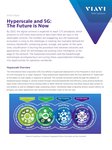Today, keeping customers satisfied is an increasingly complex task, as a burgeoning need for speed, and an ever-growing array of content delivery channels and digital connection points continue to reshape the business landscape as we know it.
Mobility has gone mainstream, and customers expect a positive experience, no matter where they are. The pressure to provide this seamless ‘anytime, anywhere’ customer experience has businesses completely rethinking the way they design their IT networks, build out IT infrastructure and ultimately interact with customers.
At the center of this shift we find Edge computing, moving computation, storage and other tasks outside the core network and nearer to the collection source, such as an IoT (Internet of Things) device. The end result? A faster, more streamlined customer experience can then be realized because the compute process and associated decision making happens closer to where the data is physically generated.
But despite the benefits, implementing the Edge doesn’t come without its network challenges.
“Because there's a lot of variability in technology and approach out there, there may be a lot of different challenges encountered in terms of getting an installation to happen cleanly and smoothly,” says VIAVI’s Adrian Parry.
“At the end of the day, customers want to get maximum ROI from the network, so VIAVI’s goal is to try to help them remove as many performance roadblocks as we can.”
Whether developing easy to use, yet powerful automated tools, or the creation of simplified but effective client certification workflows, VIAVI has been involved extensively within the network testing arena for a significant period of time. As the company has evolved and entered new markets, today, VIAVI is positioned as a key player across all main aspects of networking.
“From service provider fiber to the home (FTTH), to wireless 5G, enterprise headquarter buildings or data centers, the types of things that we are able to do, are primarily around optical testing, and ensuring that the networks which service providers or enterprises deploy will fully deliver to their expectations,” says Parry.
In addition to the data center space, VIAVI has also been engaging with many of the teams deploying fiber broadband networks on a global scale. VIAVI equipment not only verifies the backhaul networks, ensuring they are delivering as they should, but confirms that there is a clean signal from the head ends too.
“Whether these network deployments are simple or complex, we can offer the right testing solutions and workflows to not only confirm a successful deployment, but to also verify how well your network is actually performing,” explains Parry.
Defining the undefinable
We’re already seeing many colocation and hyperscale data center operators building their networks increasingly closer to the demand centers. However, there is a limit to how many medium to large data centers can be built within metropolitan areas, and in reality, one might question how effective traditional sites can be in servicing increasingly mobile applications. Therefore, developing a definite Edge-oriented approach is the next logical step in the extension of existing strategies, bringing services closer to where they’re needed most.
Yet the problem here is, the concept of Edge is still evolving. In fact, what constitutes an Edge deployment is still so broad it makes having these conversations somewhat difficult.
When asked to define the Edge, Parry said, “I think for the number of conversations that have been had about Edge over the years, there is probably an equal number of definitions.
“Edge could be a small cabinet which is in your office, and that’s duplicating what a cloud service provider is offering you. At the same time, it could be a containerized solution at the bottom of a tower, or, in reality, still be a full-sized data center. It really depends on the location and the localized requirement.
“I think there will be a lot of different configurations, sizes, shapes, and methods by which Edge is deployed and managed, it’s still evolving,” says Parry.
“But then you get some people that say, ‘Well we’ve been doing Edge for years, it's just what we call pop sites’. So it's not really anything different, but it is certainly a term that has captured the imagination.”
What’s driving the Edge?
Lately 5G has unquestionably been the star of the low latency show, but there are many other low latency applications that make incredibly strong use cases for the Edge.
“Traffic management systems where we wouldn’t want there to be any delays strike me as a very good application for this,” says Parry. “Many of the cities that are implementing these systems are also moving toward smart energy grids.”
Then you have the less mission critical applications, such as gaming. That said, try telling a serious gamer their mission isn’t critical. In this instance, the time taken between thumb and server will define how happy they are as a customer.
There has also been a lot of attention given to what people are referring to as the “Meta-verse”. As an immersive gaming or entertainment platform a great deal of local data capacity is going to be needed, but there is also interest in it from a business-focused standpoint as well, perhaps as an evolution of the virtual meeting places which have been so important in recent years.
In both scenarios, the user-experience here is going to be extremely important to the different providers all vying for dominance in what could be a very competitive market.
And it’s not just about speedy communications, we should not forget that data privacy is also becoming increasingly important, particularly from a medical perspective.
“A lot of hospitals and clinics would not want their patients' data to be shared somewhere in the cloud that they have no control over. So that's a use case for Edge where they'll set up their own cloud application data center. So it's running cloud applications, but it isn't going anywhere else,” says Parry.
Testing, testing
There might be some distinct nuances when it comes to Edge deployments, and the way they are tested. Ideally however, a highly distributed Edge environment could benefit from a proactive approach in order to satisfy the fundamental service-level criteria clients are looking to achieve.
Parry explains, “I think speed and efficiency of delivery is going to be a priority for most because it's about being agile in how we deploy resources. Not just getting something deployed quickly, but also being sure that it's going to work when it's in-place is key, as you’re potentially dealing with a lot of locations.”
He continues, “There is going to be a team that needs to manage this deployment. Therefore in an unmanned data center – which Edge facilities often are – automating monitoring and management is likely to be beneficial. It’s much more efficient to confirm if something is wrong before teams are deployed to try and resolve it, but more importantly, root cause analysis will help them to be far more efficient when it comes to problem resolution.
Up until recently, this kind of visibility has been the missing piece of the puzzle. For uptime sensitive or security conscious customers, the ability to quickly and efficiently find the precise location of a problem at the Edge could be crucial.
And automated testing isn’t only advantageous when it comes to proactive problem solving and efficiency improvements, it also comes into play in measuring the key KPIs that not only appeal to customers, but ensure the data center is compliant with current regulations.
Measures such as these may help simplify the management of a site, providing invaluable visibility and control to help ensure the longevity and reliability of an operation, which ultimately affect the bottom line. According to Gartner, by 2025 there is set to be a 75 percent rise in Edge deployments, and assurance strategies like those from VIAVI, could be what sets you apart from the competition.
More from Viavi
-

Why Viavi is proud to present Edge Centres with the Edge Data Center Project of the Year award
A deeper look at the Edge data center project of the year
-

Sponsored Putting our networks to the test
Surprisingly, perhaps, the root causes of many network problems point towards errors during installation
-

DCD>Talks Networks with Sameh Yamany, VIAVI Solutions
Sameh Yamany, Chief Technology Officer, VIAVI Solutions chats exclusively with George Rockett from DCD.

